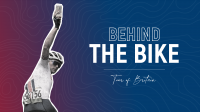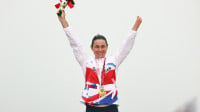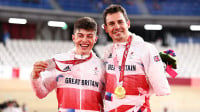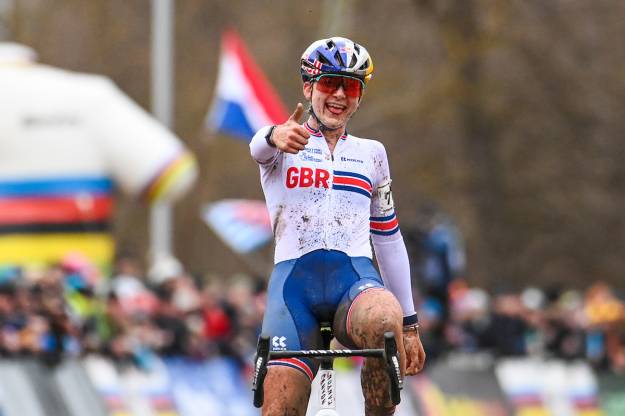Published: 1 June 2012![]()
Words: Simon Powers
We are all familiar with many of the riders and coaches responsible for the great performances of the Great Britain Cycling Team. But in the lead up to this summer’s Games, we’re taking the opportunity to have a look at some of the staff from the Great Britain Cycling team who tend to go unnoticed but without whom, the team could not function.
As British Cycling’s sole biomechanist, the optimum performance of some of the most successful cyclists of all time is, in part, down to Paul Barratt. Working for the Great Britain Cycling Team on behalf of the English Institute of Sport Barratt is responsible for – in his own words – understanding forces that humans produce and the result of those forces.
Barratt has a broad range of tasks to fulfil and began working within cycling after a time in water polo, squash and even bob skeleton.
“I have been working with British Cycling ever since Beijing. It has been predominantly Track Sprint based; with these guys it’s more based on day to day provision, while other disciplines focus on specific issues that may arise with a rider or coach”.
Within his role, Barratt also works closely with the Research and Development team looking at ways to improve equipment and aerodynamics to further the performance of riders in competition.
“I work closely with the R&D department and although I don’t see myself as a key member of the team my role is to collect information on a variety of aspects such as aerodynamics enabling me to provide data to support the work that they do”.
Bimoechanics is an often overused term in sport. There are only a handful of biomechanists in the EIS system of which Barratt is one of them.
“The purpose of any sporting activity is for the individual to produce power. What we do is to look for ways in which we can improve power output. The way I look at it is in terms of how people move, how their bikes are set up and looking for ways in which their power output can be increased.”
“People like to use Biomechanics to mean technique analysis, but this is not the whole picture. Basically by understanding how humans produce those forces in any sporting activity, across all sports, what you ultimately want to do is produce power. It’s about altering the techniques people use to produce force or alter the way they train to help them produce even greater force and at the end of the day, to produce more power which is the main aim.”
DATA SOURCES.
Cycling is unlike most other sports in that a lot of data can be collected about the bike set up, positioning and performance on the bike itself. Barratt admits that this is, in fact, the envy of most other sports biomechanists.
“In cycling we are incredibly lucky to be able to measure everything we are able to. The amount of data that you can collect is probably the envy of every other sport to be honest. You have the force data, which in biomechanics, is called kinetics and the motion analysis which is called kinematics. With those two pieces of information, you have most of the data you would need to get to the bottom of the vast majority of issues you would want to address within cycling performance.
“We have instrumentation to put on bikes to collect force and power information. The main instrument for this is the SRM system, this is probably the best known and still seen as the gold standard for power measurement. It gives almost lab quality data from a track bike in situ. It gives power and force data from a track bike which is very accurate for any field test.
“In addition to this commercially available kit, we also have some bespoke apparatus either made by us or made in partnership with certain companies such as McLaren F1. These allow us to collect data often at much higher sampling rates than an SRM would, which ultimately increases our accuracy in recording.”
EVENTS
The role of the sports science group is to provide information to coaches to help them make better decisions. When coaches have to make a decision regarding some form of training, bike set up or strategy, it is their job to provide information to the coach to enable them to make the most informed decision possible.
“As the things I do are very detailed and often need interpretation, it is unlikely that I would do this at an event itself. This is unlike many other sports where quick data can be collected and passed on to a coach. At competitions, we will collect information on power and high speed video for example but we wouldn’t be responsible for giving information on what we have collected to coaches during the course of that competition.
“It is after the competition when a full debrief is held with all the coaches when we will try to tease out some of the information which is not immediately obvious. This will also include data on opposition analysis, looking at things like what type of equipment they use or trying to predict what gear they are on. Then we will look at individual rider performance and see if there is anything we can enlighten the coaches on so that they can help progress that rider in future competition.”
BETWEEN NOW AND THE GAMES
Most of the time the sports science group have is now focused on looking after the riders who are in contention for a place at the Olympics.
“If there are specific issues with key riders that we feel we can assist in between now and the Games then that will take up the majority of our time over the next nine weeks.”
In addition to this, the data collected by staff such as Barratt will be used to help decide who will represent Great Britain in the new one per nation format track event this summer.
“We have collected plenty of data and this will be helpful to those who are tasked with making such decisions. We will pass on every ounce of data we have so that it can be pored over and help ensure the decision will be the correct one. That’s as far as it goes with that though, it certainly isn’t our call.”









